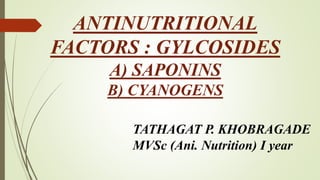
ANITINUTRITION FACTOR GYLCOSIDES SAPONINS CYANODENS
- 1. ANTINUTRITIONAL FACTORS : GYLCOSIDES A) SAPONINS B) CYANOGENS TATHAGAT P. KHOBRAGADE MVSc (Ani. Nutrition) I year
- 2. INTRODUCTION:- Antinutritional Factors (ANFs): • Defined as those substances present in the diet which by themselves or their metabolic products arising in the system interfere with the feed utilization, reduce production or affects the health of the animal. • These anti-nutritive substances are often referred to as “toxic factors” because of the deleterious effects they produce when eaten by animals. According to their Chemical Properties They are Protein , Gylcosides, Phenols, Miscellaneous
- 3. This include 1. Saponins 2. Cyanogens 3. Glucosinolates (Goitrogens) Glycosides • Glycosides are usually compounds of plant origin. They are made up of one or more sugars combined with an alcohol, a phenol, or a complex molecule such as a steroid nucleus. • Contain CHO and non –CHO group (Aglycone)
- 4. • Saponins are a heterogenous group of naturally occurring foam - producing triterpene or steroidal glycosides that occur in a wide range of plants. • characterized by bitter taste, • foaming in aqueous solution, • haemolyse RBC Saponins: They are able to form complexes with sterols, including those associated with the plasma membranes of animal cells.
- 5. Saponins are less important because their levels are low in most common feed ingredients for monogastric animals. In Ruminants they are toxic when fed in excess amount, because their diet contain more saponins than monogastric. The important common sources which cause saponin poisoning of livestock are:- • Sources of Saponins Lucerne (Alfalfa) Soya bean Kidney bean (Rajma) Lentil (Masoor) Groundnut Sunflower
- 6. Effects of Saponins Bloat Excess feeding of green lucerne or legume forages saponins lower the surface tension of ruminal contents leading to accumulation of gas (CO2 and CH4), condition is known as “bloat” This is also know as tympany/tympnitis. Formation of Foam in the Rumen The presence of saponins has been cited as one of the factors responsible for formation of foam in the rumen and thereby gas is trapped in the rumen contents with the result of which animals can not eliminate it by belching. Haemolysis of RBC Saponins are capable of destroying red blood cells (RBCs) by dissolving their membranes, a process known as haemolysis, releasing free haemoglobin into the bloodstream. Saponins also have found to inhibit the actions of certain enzymes. E.g., chymotrypsin because they interact with substrate-enzyme interaction.
- 7. Other secondary effects of Saponin In general the effects of ingestion of saponins include excessive salivation, increased respiratory tract secretion, gastroenteritis, vomiting, diarrhoea, haemolysis, haematuria, damage to livers and kidney tissues, cystitis, bloating, reduction of gastric motility,, reduction of food intake, reduction of growth rate. In Poultry 0.4 – 0.5 % saponin in feed depress feed consumption. Egg production and body weights are also depress TREATMENT AND PREVENTION OF SAPONIN TOXICITY Turpentine and paraffin oil are helpful in reducing bloat. For ruminants 1 to 2 kg dry fodder should be fed before letting the animals for legume pastures or before excessive feeding of green legume fodders as a preventive measure. Water soaking and rinsing will remove their components in the feedstuffs. Chemically saponins are glycosides which on hydrolysis yield surgars.
- 8. Cyanogens • Cynogenetic glycoside compounds consist of α-hydroxynitrile aglycones attached to a sugar moiety and are widely distributed in the plant kingdom. • In plants the Glycoside is non-toxic in the intact tissues. • These glycosides can be hydrolyzed to prussic acid or hydrocyanic acid (HCN) by the enzyme usually present in the same plant or as they are being are being digested by animals. • This reaction can take place in the rumen microbial activity.
- 9. • The HCN is rapidly absorbed and some is eliminated through the lungs, but the greater part is rapidly detoxified in the liver by conversion to thiocyanate. • Ruminants are more susceptible to HCN poisoning than are horses and pigs because the enzyme required for the release of HCN is destroyed in horses and pigs by the gastric HCI. There are three distinct glycosides: • Amygdalin : Almonds • Dhurrin : Jowar and other immature grasses • Linamarin : Linseed, Cassava , Java Beans Cynogens Plant source • Heavy nitrate fertilization followed by an abundant irrigation or rainfall may increase the potential of HCN poisoning of these crops.
- 10. 1. Cyanide taken to the body 2. It’s rapidly absorbed and circulated 3. It is merged with methemoglobin and forms cyanomethemoglobin. 4. The circulating cyanide inactivates cytochrome oxidase enzyme by binding ferric (Fe+++) iron which is within this enzyme. 5. Normally the cytochrome oxidase enzyme catalyzes the last step of oxidative phosphorylation. 6. The enzyme-cyanide complex prevents this task from being performed. 7. The enzyme cannot combine with oxygen and electron transportation become inhibited. 8. The animal cannot use oxygen and cellular respiration stops immediately. 9. Death occurs due to histotoxic anoxia and ATP depletion. Mechanism of action
- 11. Clinical signs of Cyanide Poisoning • Dyspnea, labored breathing, restlessness, mental confusion, ataxia, convulsions are the clinical signs in affected animals. • Initially bright and cherry-red colored mucous membranes are noticed. • When patient becomes hypoxic, mucous membranes become cyanotic • Cyanide can cause death in a short amount of time, due to hypoxia which is reduction of oxygen in tissues. TREATMENT AND PREVENTION OF CYANIDE POISONING For Cattle: I/V with 3.0g Sodium Nitrate and 15.0 g Sodium Thiosulphate in 200 ml H2O. For Sheep: I/V with 1.0g Sodium Nitrate and 2.5 g Sodium Thiosulphate in 50 ml H2O.
- 12. Feeding of immature jowar green fodder should be avoided to prevent HCN poisoning. Drying plants decreases the cyanogenic potential over time. Ensiling plants will significantly reduce the cyanogenic glycoside content. Sun-curing of hay will reduce HCN, especially if the hay is crimped. Dhurrin will be hydrolyzed and HCN evaporates in gaseous form.